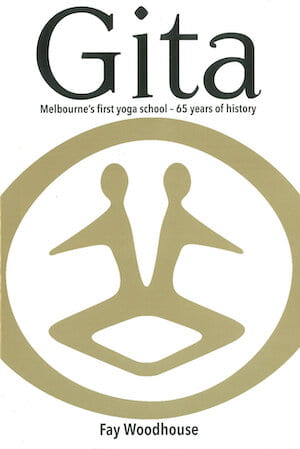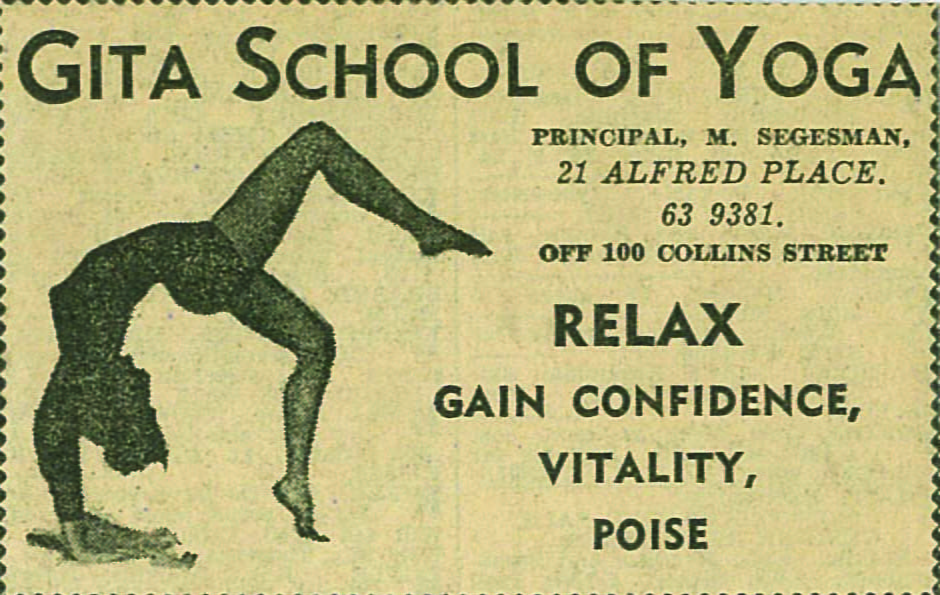
Gita Yoga: Interview with Dr Fay Woodhouse
In October 2020, SHAPS Fellow Fay Woodhouse released her new book, Gita: Melbourne’s First Yoga School – 65 Years of History, exploring the different phases of Melbourne’s first full-time permanent yoga school, founded in 1954. Nicole Davis chatted to Fay about the book, the history of Gita Yoga, and its place in Melbourne’s and Australia’s yoga tradition, past and present.
What led you to write the history of Gita Yoga?
I had studied to become a yoga teacher in the 1980s and attended classes at Gita early in my career as a teacher and then much more recently in the 2010s. I had long been interested in the history of yoga in Australia, wondering why certain styles of yoga arrived in Australia at different times. I was very keen to compile an encyclopedia of Australian yoga schools tracing their histories, but could not find anyone to finance such a publication.
In the year 2014, although I had not trained to become a teacher at Gita, I attended a conference for yoga teachers; this conference made me realise how important the history of Gita was, so I asked the two Principals if I could write the school’s history. This history was not commissioned – I financed and published it totally myself. The school allowed me to use their archive for the three years I worked on researching and writing the book.

Can you tell us a little about the beginnings of Gita Yoga?
Yoga teaching began in Melbourne soon after the Swiss national, Margaritha (Margrit) von Segessemann (1905–1998) arrived here in October 1954. Margrit had studied yoga in India and the mountains of Tibet for around seven years. Her guru had sent her back to India and on a mission to teach yoga to ‘the West’. En route to Sydney and then the United States of America, she stopped in Melbourne and decided that this was the place she would teach yoga. She soon found accommodation and work and began teaching yoga at night in her large flat in East St Kilda.
Yoga was a very new thing in the mid-1950s, and many people were fascinated with it. After five years of teaching in her flat, Margrit was interviewed on ABC Radio in Melbourne and from that time the increasing demand for classes encouraged her to find a building in central Melbourne and to begin teaching full-time. She leased a building at 21 Alfred Place, the ‘Paris End’ of Collins Street and her classes immediately became very popular.
Gita was the first full-time yoga school in Melbourne. Margrit named her school ‘The Gita School of Yoga’ for two reasons: first, ‘Gita’ was her pet name as a child (derived from Margaritha); and second, while living at the ashram in India she was initiated as Swami Gitananda of the lineage of Sri Yukteswar Giri and Paramahansa Yogananda.

What was the yoga ‘scene’ like in Melbourne at the time?
Prior to Margrit’s arrival in Melbourne in October 1954, there was no yoga ‘scene’. Yoga demonstrations by Sir Paul Dukes had taken place in the 1940s in Melbourne but from my research, I was unable to find anyone teaching yoga in Melbourne prior to 1954.
Yoga came to Australia in 1949–1950. Michael Volin, a White Russian living in Shanghai and teaching yoga there, emigrated to Australia after the Communist Party took over in China in 1949. Volin taught yoga in Sydney from 1950. He was one of two yoga teachers to arrive in Australia at this time. The other was the Frenchman, showman and surely a charlatan, Dr Serge la Ferriere, who taught in Perth from 1950.
Margrit was the first yoga teacher in Melbourne. Prior to her arrival, articles and stories about yoga and meditation could be found in newspapers and women’s magazines. The Theosophical Society had been publishing articles on these topics from the late nineteenth century and they became more popular during the 1930s.
Margrit’s mission was to teach yoga but she was determined to ‘break the guru tradition’. She taught yoga and meditation the way she had been taught – in the Yogananda method.
In the 1970s and 1980s other yoga teachers (Indian schools, now ‘brands’) began coming to Australia – they included Swami Venkatesada, Maharishi Mahesh Yogi, Swami Satyananda, Swami Sivananda, as well as B K S Iyengar and Oki Do, all began teaching during this time.

How has the perception of yoga and way we practice Yoga changed over that time?
Initially in the 1950s and up until the 1980s, yoga was often seen as a religious cult or something similar. People were suspicious of the idea of yoga. However, over time it has become as much a part of mainstream health and fitness as athletics or tennis.
The current teaching of yoga is vastly different to the style and manner in which Margrit Segesman taught in 1954. I think it is true to say that she would not recognise what is being taught now as ‘yoga’. Today yoga is a product and a billion-dollar business worldwide. Hot Yoga and various other styles of yoga were integrated into the Melbourne yoga scene in the 1990s and today there are styles too numerous to count.

What contribution did Gita make to the practice of yoga in Melbourne (or Australia)? What does Gita continue to bring to the yoga community in the 2020s?
The thesis of my book Gita: Melbourne’s First Yoga School – 65 years of history, is that Yoga in Australia would not be what it is today without Gita Yoga. The book tells the story of Margrit, as well as the part played by Australia’s other early yoga teachers, Michael Volin, Nancy Phelan and Roma Blair. These teachers all worked hard to demonstrate the benefits of yoga, especially to women’s lives.
The history of Gita is very much a story of women. When it was first taught in the 1950s, yoga was initially promoted as a major benefit for women. As women’s roles were changing with the second wave of feminism in the 1970s, yoga offered women both a healthy regime and a viable career path.
The emergence of yoga, meditation and other related associations increased the professionalism of yoga teaching and Gita contributed to their establishment. Teacher training, newsletters and overseas retreats were all initiated at Gita from the 1980s onwards. When Margrit Segesman retired in 1983 she chose two students, Lucille Wood and Di Lucas, to carry on the work she had begun. They have been running the school together since 1983. Margrit died in 1998. This history explores in detail the everyday life of the school and its current owners and demonstrates that the yoga scene in Australia would not be what it is today without Gita, Melbourne’s first full-time yoga school.
Gita Yoga (now Gita International) continues to contribute to the yoga community through its teacher training courses and (when possible) live meditation and yoga classes. The structure of their school changed prior to COVID-19 when Lucille and Di made the decision to go online, something that many other schools had done successfully. The Melbourne yoga community remains vibrant with Lucille and Di now revered as two of the wise elders, happy to contribute their knowledge and experience to the community.
Further information about Gita, including classes and courses, can be found on its website and read more about the launch of Fay’s book launch. You can purchase Fay’s fascinating book from her website.
Fay will be giving an online talk about her research: “Job Done: What We Have Learned about 65 Years of Yoga In Australia,” for the SHAPS Fellows & Associates Seminar, on Wednesday 31 March 2021 at 5:30pm AEST. All welcome!